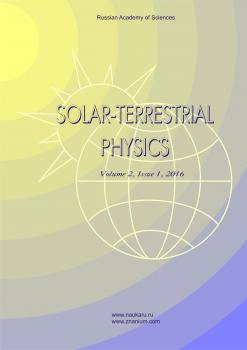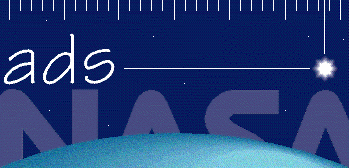Irkutsk, Russian Federation
Irkutsk, Russian Federation
It is shown that the convection reversal boundary is a fundamental parameter of the magnetosphere-ionosphere coupling, which determines a strong analogy between the electrostatic potential of the ionosphere and the equivalent current function in the dipole geomagnetic field approximation and the uniform ionospheric conductance. We have developed a new ground-based method for automatically diagnosing boundaries of the auroral oval using output data obtained with the magnetogram inversion technique (MIT). Using maps of the current function and field-aligned currents, calculated at the first stage of MIT with uniform ionospheric conductance, we determine the convection reversal boundary, polar cap boundary, equatorial boundary of the auroral oval, and line of maximum density of auroral electrojets. These parameters have previously been determined by a visual-manual method: analyzing maps of field-aligned and equivalent currents on the monitor screen and carrying out predetermined boundaries with the mouse — this took a very long time (weeks and months). The comparison between manually and automatically obtained boundaries has shown that the correlation coefficient between the two boundaries is, on average, 0.85, and the root-mean-square deviation does not exceed 2° in latitude. By providing an adequate accuracy for the boundary determination, the automatic method reduces the time for map processing by a factor of 2–3 (to minutes and hours), releasing a researcher from laborious visual work. The new method is implemented as one of the important modules in the updated MIT software.
ionospheric convection, equivalent current function, auroral oval, polar cap, field-aligned currents, convection reversal boundary
1. Akasofu S.I. Polar and Magnetospheric Substorms. Dordrecht, Holland, Springer Netherlands, 1968, 280 p. DOI:https://doi.org/10.1007/978-94-010-3461-6.
2. Akasofu S.I. Physics of Magnetospheric Substorms. Dordrecht, Holland, Springer Netherlands, 1977, 617 p. DOI:https://doi.org/10.1007/978-94-010-1164-8_1.
3. Alfvén H. Cosmic plasma. Dordrecht, Holland, Springer Netherlands, 1981, 168 p. DOI:https://doi.org/10.1007/978-94-009-8374-8.
4. Axford W.I., Hines C.O. A Unifying theory of high-latitude geophysical phenomena and geomagnetic storms. Can. J. Phys. 1961, vol. 39, no. 10, pp. 1433-1464. DOI:https://doi.org/10.1139/p61-172.
5. Baker D.N., Peterson W.K., Eriksson S., Li X., Blake J.B., Burch J.L., Daly P.W., Dunlop M.W., Korth A., Donovan E., Friedel R., Fritz T.A., Frey H.U., Mende S.B., Roeder J., Singer H.J. Timing of magnetic reconnection initiation during a global magnetospheric substorm onset. Geophys. Res. Lett. 2002, vol. 29, no. 24, pp. 2190. DOI:https://doi.org/10.1029/2002GL015539.
6. Bazarzhapov A.D., Mishin V.M., Shpynev G.B. A mathe-matical analysis of geomagnetic variation fields. Gerlands Beitr. Geophysik. 1976, vol. 85, no. 1, pp. 76-82.
7. Bazarzhapov A.D., Matveev M.I., Mishin V.M. Geomagnitnye variatsii i buri [Geomagnetic Variations and Storms]. Novosibirsk, Nauka Publ. 1979, 248 p. (In Russian).
8. Boakes P.D., Milan S.E., Abel G.A., Freeman M.P., Chisham G., Hubert B., Sotirelis T. On the use of IMAGE FUV for estimating the latitude of the open/closed magnetic field line boundary in the ionosphere. Ann. Geophys. 2008, vol. 26, no. 9, pp. 2759-2769. DOI:https://doi.org/10.5194/angeo-26-2759-2008.
9. Boström R. Ionosphere-magnetosphere coupling. Mag-netospheric Physics. Ed. by B.M. McCormac. D. Reidel Publishing Company, Dordrecht-Holland, 1974, pp. 45-59.
10. Bristow W.A., Spaleta J. An investigation of the characteristics of the convection reversal boundary under southward interplanetary magnetic field. J. Geophys. Res.: Space Phys. 2013, vol. 118, no. 10, pp. 6338-6351. DOI: 10.1002/ jgra.50526.
11. Chapman S., Bartels J. Geomagnetism. Vol. 2. Great Britain, Oxford University Press, 1940, 520 p.
12. Chen Y.J., Heelis R.A., Cumnock J.A. Response of the ionospheric convection reversal boundary at high latitudes to changes in the interplanetary magnetic field. J. Geophys. Res.: Space Phys. 2015, vol. 120, no. 6, pp. 5022-5034. DOI: 10.1002/ 2015ja021024.
13. Drake K.A., Heelis R.A., Hairston M.R., Anderson P.C. Electrostatic potential drop across the ionospheric signature of the low-latitude boundary layer. J. Geophys. Res. 2009, vol. 114, no. A4. DOI:https://doi.org/10.1029/2008ja013608.
14. Dungey J.W. Interplanetary magnetic field and the auroral zones. Phys. Rev. Lett. 1961, vol. 6, no. 2, pp. 47-48. DOI:https://doi.org/10.1103/PhysRevLett.6.47.
15. Feldstein Y.I. Polar auroras, polar substorms, and their relationships with the dynamics of the magnetosphere. Rev. Geophys. 1969, vol. 7, no. 1-2, pp. 179-218. DOI:https://doi.org/10.1029/RG 007i001p00179.
16. Feldstein Y.I. The discovery and the first studies of the auroral oval: A review. Geomagnetism and Aeronomy. 2016, vol. 56, no. 2, pp. 129-142. DOI:https://doi.org/10.1134/s0016793216020043.
17. Feldstein Y.I., Starkov G.V. Dynamics of auroral belt and polar geomagnetic disturbances. Planet. Space Sci. 1967, vol. 15, no. 2, pp. 209-229. DOI:https://doi.org/10.1016/0032-0633(67)90190-0.
18. Fukushima N. Generalized theorem for no ground magnetic effect of vertical currents connected with Pedersen currents in the uniform-conductivity ionosphere. Report of Ionosphere and Space Research in Japan. 1976, vol. 30, no. 1-2, pp. 35-40.
19. Gjerloev J.W. The SuperMAG data processing technique. J. Geophys. Res. 2012, vol. 117, no. A9, pp. A09213. DOI: 10.1029/ 2012ja017683.
20. Gussenhoven M.S., Hardy D.A., Heinemann N. Systematics of the equatorward diffuse auroral boundary. J. Geophys. Res. 1983, vol. 88, no. A7, pp. 5692-5708. DOI:https://doi.org/10.1029/JA088iA07p05692.
21. Haaland S., Lybekk B., Maes L., Laundal K., Pedersen A., Tenfjord P., Ohma A., Østgaard N., Reistad J., Snekvik K. North-south asymmetries in cold plasma density in the magnetotail lobes: Cluster observations. J. Geophys. Res.: Space Phys. 2017, vol. 122, no. 1, pp. 136-149. DOI:https://doi.org/10.1002/2016ja023404.
22. Haines G.V., Torta J.M. Determination of equivalent current sources from spherical cap harmonic models of geomagnetic field variations. Geophys. J. Int. 1994, vol. 118, no. 3, pp. 499-514. DOI:https://doi.org/10.1111/j.1365-246X.1994.tb03981.x.
23. Harang L. The mean field of disturbance of polar geomagnetic storms. Terr. Magn. Atmos. Electr. 1946, vol. 51, no. 3, pp. 353-380. DOI:https://doi.org/10.1029/TE051i003p00353.
24. Heikkila W.J. Earth’s Magnetosphere: Formed by the Low-Latitude Boundary Layer. Amsterdam, Elsevier Science, 2011, 536 p. DOI:https://doi.org/10.1016/B978-0-444-52864-3.10012-7.
25. Heppner J.P. Electric field variations during substorms: OGO-6 measurements. Planet. Space Sci. 1972, vol. 20, no. 9, pp. 1475-1498. DOI:https://doi.org/10.1016/0032-0633(72)90052-9.
26. Hubert B., Aikio A.T., Amm O., Pitkänen T., Kauristie K., Milan S.E., Cowley S.W.H., Gérard J.C. Comparison of the open-closed field line boundary location inferred using IMAGE-FUV SI12 images and EISCAT radar observations. Ann. Geophys. 2010, vol. 28, no. 4, pp. 883-892. DOI:https://doi.org/10.5194/angeo-28-883-2010.
27. Iijima T., Potemra T.A. Large-scale characteristics of field-aligned currents associated with substorms. J. Geophys. Res. 1978, vol. 83, no. A2, pp. 599-615. DOI:https://doi.org/10.1029/JA083i A02p00599.
28. Kamide Y., Matsushita S. Simulation studies of ionospheric electric fields and currents in relation to field-aligned currents. 1. Quiet periods. J. Geophys. Res. 1979, vol. 84, no. A8, pp. 4083-4098. DOI:https://doi.org/10.1029/JA084iA08p04083.
29. Kamide Y., Richmond A.D. Ionospheric conductivity dependence of electric fields and currents estimated from ground magnetic observations. J. Geophys. Res. 1982, vol. 87, no. A10, pp. 8331-8337. DOI:https://doi.org/10.1029/JA087iA10p08331.
30. Kamide Y., Baumjohann W. Magnetosphere-ionosphere coupling. Berlin, Springer Berlin Heidelberg, 1993, 178 p. DOI:https://doi.org/10.1007/978-3-642-50062-6.
31. Kern J.W. Analysis of Polar Magnetic Storms. J. Geomag. Geoelectr. 1966, vol. 18, no. 2, pp. 125-131. DOI:https://doi.org/10.5636/jgg. 18.125.
32. Koustov A.V., Fiori R.A.D. Seasonal and solar cycle variations in the ionospheric convection reversal boundary location inferred from monthly SuperDARN data sets. Ann. Geophys. 2016, vol. 34, no. 2, pp. 227-239. DOI:https://doi.org/10.5194/angeo-34-227-2016.
33. Laundal K.M., Haaland S.E., Lehtinen N., Gjerloev J.W., Østgaard N., Tenfjord P., Reistad J.P., Snekvik K., Milan S.E., Ohtani S., Anderson B.J. Birkeland current effects on high-latitude ground magnetic field perturbations. Geophys. Res. Lett. 2015, vol. 42, no. 18, pp. 7248-7254. DOI: 10.1002/ 2015gl065776.
34. Lazutin L.L. Auroral oval as a beautiful but outdated paradigm. Solnechno-zemnaya fizika [Solar-Terrestrial Phys.]. 2015, vol. 1, no. 1, pp. 23-35. DOI:https://doi.org/10.12737/5673. (In Russian).
35. Longden N., Chisham G., Freeman M.P., Abel G.A., Sotirelis T. Estimating the location of the open-closed magnetic field line boundary from auroral images. Ann. Geophys. 2010, vol. 28, no. 9, pp. 1659-1678. DOI: 10.5194/ angeo-28-1659-2010.
36. Makita K., Meng C.I., Akasofu S.I. The shift of the auroral electron precipitation boundaries in the dawn-dusk sector in association with geomagnetic activity and interplanetary magnetic field. J. Geophys. Res. 1983, vol. 88, no. A10, pp. 7967-7981. DOI:https://doi.org/10.1029/JA088iA10p07967.
37. Makita K., Meng C.I., Akasofu S.I. Temporal and spatial variations of the polar cap dimension inferred from the precipitation boundaries. J. Geophys. Res. 1985, vol. 90, no. A3, pp. 2744-2752. DOI:https://doi.org/10.1029/JA090iA03p02744.
38. Matveev M.I., Shpynev G.B. Determination of electric fields and field-aligned currents in the magnetosphere on data of geomagnetic variations (high-latitude region). Issledovaniya po geomagnetizmu, aeronomii i fizike Solntsa [Research on Geomagnetism, Aeronomy and Solar Physics]. 1975, no. 36, pp. 34-39. (In Russian).
39. Milan S.E., Provan G., Hubert B. Magnetic flux transport in the Dungey cycle: A survey of dayside and nightside reconnection rates. J. Geophys. Res. 2007, vol. 112, no. A1, pp. A01209. DOI:https://doi.org/10.1029/2006ja011642.
40. Milan S.E., Evans T.A., Hubert B. Average auroral configuration parameterized by geomagnetic activity and solar wind conditions. Ann. Geophys. 2010, vol. 28, no. 4, pp. 1003-1012. DOI:https://doi.org/10.5194/angeo-28-1003-2010.
41. Mishin V.M. The magnetogram inversion technique and some applications. Space Sci Rev. 1990, vol. 53, no. 1-2, pp. 83-163. DOI:https://doi.org/10.1007/bf00217429.
42. Mishin V.M., Shpynev G.B., Bazarshapov A.D., Shirapov D.S. Electric field and currents in the nonuniformly-conductive high-latitude ionosphere. Issledovaniya po geomagnetizmu, aeronomii i fizike Solntsa [Research on Geomagnetism, Aeronomy and Solar Physics]. 1981, no. 53, pp. 116-133. (In Russian).
43. Mishin V.M., Lunyushkin S.B., Shirapov D.S., Baumjohann W. A new method for generating instantaneous ionospheric conductivity models using ground-based magnetic data. Planet. Space Sci. 1986, vol. 34, no. 8, pp. 713-722. DOI:https://doi.org/10.1016/0032-0633(86)90125-x.
44. Mishin V.M., Mishin V.V., Lunyushkin S.B., Wang J.Y., Moiseev A.V. 27 August 2001 substorm: Preonset phenomena, two main onsets, field-aligned current systems, and plasma flow channels in the ionosphere and in the magnetosphere. J. Geophys. Res.: Space Phys. 2017, vol. 122, no. 5, pp. 4988-5007. DOI:https://doi.org/10.1002/2017ja023915.
45. Newell P.T., Liou K., Zhang Y., Sotirelis T., Paxton L.J., Mitchell E.J. OVATION Prime-2013: Extension of auroral precipitation model to higher disturbance levels. Space Weather. 2014, vol. 12, no. 6, pp. 368-379. DOI:https://doi.org/10.1002/2014sw001056.
46. Reiff P.H. Models of auroral-zone conductances. Magnetospheric Currents. Ed. by T.A. Potemra, Washington, DC, AGU, 1984, pp. 180-191. DOI:https://doi.org/10.1029/GM028p0180.
47. Russell C.T., McPherron R.L. The magnetotail and substorms. Space Sci Rev. 1973, vol. 15, no. 2-3, pp. 205-266. DOI:https://doi.org/10.1007/bf00169321.
48. Shirapov D.S., Mishin V.M., Bazarzhapov A.D., Saifudinova T.I. Adapted dynamic model of ionospheric conductivity. Geomagnetism and Aeronomy. 2000, vol. 40, no. 4, pp. 471-475.
49. Shukhtina M.A., Gordeev E.I., Sergeev V.A., Tsyganenko N.A., Clausen L.B.N., Milan S.E. Magnetotail magnetic flux monitoring based on simultaneous solar wind and magnetotail observations. J. Geophys. Res.: Space Phys. 2016, vol. 121, no. 9, pp. 8821-8839. DOI:https://doi.org/10.1002/2016ja022911.
50. Sotirelis T., Newell P.T. Boundary-oriented electron precipitation model. J. Geophys. Res. 2000, vol. 105, no. A8, pp. 18655-18673. DOI:https://doi.org/10.1029/1999ja000269.
51. Sugiura M. A fundamental magnetosphere-ionosphere coupling mode involving field-aligned currents as deduced from DE-2 observations. Geophys. Res. Lett. 1984, vol. 11, no. 9, pp. 877-880. DOI:https://doi.org/10.1029/GL011i009p00877.
52. Sun W., Lee L.C., Kamide Y., Akasofu S.I. An improve-ment of the Kamide-Richmond-Matsushita scheme for the estimation of the three-dimensional current system. J. Geophys. Res. 1985, vol. 90, no. A7, pp. 6469-6474. DOI: 10.1029/ JA090iA07p06469.
53. Troshichev O.A., Shishkina E.M., Lu G., Richmond A.D. Relationship of the ionospheric convection reversal to the hard auroral precipitation boundary. J. Geophys. Res. 1996, vol. 101, no. A7, pp. 15423-15432. DOI:https://doi.org/10.1029/96ja01192.
54. Vasyliūnas V.M. Mathematical Models of Magnetospheric Convection and its Coupling to the Ionosphere. Particles and Fields in the Magnetosphere. Ed. by B.M. McCormac, Springer Netherlands, 1970, pp. 60-71. DOI:https://doi.org/10.1007/978-94-010-3284-1_6.
55. Vorobjev V.G., Yagodkina O.I., Katkalov Y.V. Auroral Precipitation Model and its applications to ionospheric and magnetospheric studies. J. Atmos. Solar- Terr. Phys. 2013, vol. 102, pp. 157-171. DOI:https://doi.org/10.1016/j.jastp.2013.05.007.
56. Winningham J.D., Heikkila W.J. Polar cap auroral electron fluxes observed with Isis 1. J. Geophys. Res. 1974, vol. 79, no. 7, pp. 949-957. DOI:https://doi.org/10.1029/JA079i007p00949.
57. URL: http://supermag.jhuapl.edu (accessed June 2, 2018).
58. URL: http://vt.superdarn.org/tiki-index.php (accessed June 2, 2018).

















